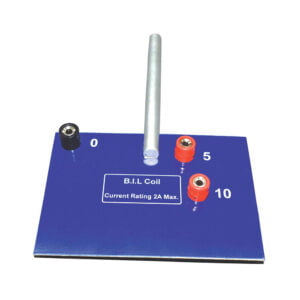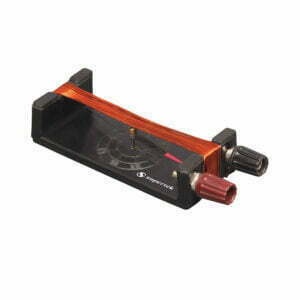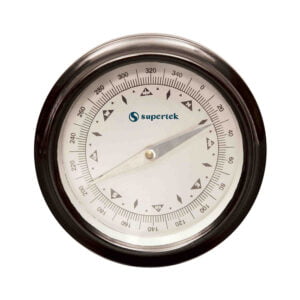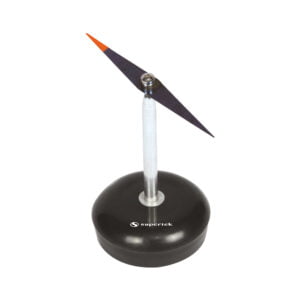Magnetism
-
Magnetism
Force Between Conductors Demonstrator
An easy and safe way to demonstrate the magnetic force between two current carrying parallel conductors. A cylindrical base, containing a dedicated power supply, supports a rectangular frame. Attached inside the frame are two parallel heavy duty metal tubes supported by fine cone bearings which also supply current to the tubes. The directions of the currents in the tubes can be selected, and movable metal arrows on the frame uprights indicate the current direction in each tube. A push button applies a large current at low voltage to the tubes, which then swing together or apart, depending on whether the tube currents are in the same or opposite directions.
PH41171 -
Magnetism
Force on a Conductor Balance
To demonstrate that when a current is passed through a conductor in a magnetic field, it is subjected to attraction or repulsion depending upon the direction of current in it. The apparatus consists of a plastic base 9″ x 6″ x 1″ on which two contact pillars are mounted. Each pillar is provided with an external circuit. A balanced beam is supported by the pillars on two bearings which form the fulcrum. Two screwed masses are provided in the beam system, one moving vertically for the adjustment of sensitivity and the other moving horizontally for the adjustment of the equilibrium position, when no current is flowing. Scale is marked 0-80 x 1 mm and rider is of 1 gm. Includes instruction manual.
PH41172B -
Magnetism
B.I.L Coil
A printed circuit board coil with 5 and 10 turns. It can be placed between the poles of a permanent magnet on the top pan of a digital balance so that when a current is passed through it, a force is exerted on the magnet due to the magnetic effect of the current. Quantitative measurements can be taken to investigate the formula F = BIL.
PH41173 -
Magnetism
Helmholtz Coils
Helmholtz Coils are a special arrangement of coils that are placed in such a way as to generate a very uniform magnetic field between them when a current is applied. The strength of the magnetic field is proportional to the number of turns in the coils and the current applied to them. The Supertek Helmholtz Coils setup consists of two field coils mounted on a track to provide a uniform magnetic field between the coils. The proper separation for Helmholtz coils is marked on the track. A pair of precision coils and 400 turns of wire are wound on heat-resistant former of about 150 mm diameter.
PH41176 -
Magnetism
Helmholtz Coil
Pair of coils for generating a uniform magnetic field perpendicular to the axis of a tube.
Specifications:
- Coil diameter: 300 mm approx.
- Coil spacing: 150 mm.
- Number of turns per coil: 124.
- Enamelled copper wire thickness: 1.2 mm.
- DC resistance: 2 Ohms each.
- Maximum coil current: 5.5 A.
- Maximum coil voltage: 6 V.
- Maximum flux density at 5 A: 2 mT.
PH41176B -
Magnetism
Magnetometer
A plastic box with aluminium dial graduated in 0 – 90° four times, anti-parallax mirror and steel pivot. The short magnetic needle has a synthetic sapphire bearing and a light aluminium pointer designed for precise readings and maximum damping. The compass box has a hollow circular cavity to fit tangent galvanometer stand or deflection magnetometer base.
PH41180 -
-
Magnetism
Tangent Galvanometer
Classic demonstration of how a current loop generates a magnetic field. Two coils of insulated wire, with 5 and 10 turns respectively, are wound around a plastic ring. The ring is mounted on a plastic base with 3 binding posts that allow connection to five, ten, or fifteen turns of wire. A magnetic compass (included) can be placed on the base to observe and measure deflection of the compass. With compass 38mm Includes instructions.
PH41187B -
Magnetism
Tangent Galvanometer
Supertek tangent galvanometer is used to investigate the magnitude and direction of the magnetic field produced by a current-carrying conductor. The apparatus may also be used to determine the magnitude and direction of the horizontal component of the earth’s magnetic field. In this tangent galvanometer, 305 cm of wire is wound on the nonmagnetic stand, which is of a sturdy design. 4mm sockets are provided for the input. Supplied with user manual.
PH41187E -
Magnetism
Tangent Galvanometer
Investigate magnetic fields produced by an electric current. Students observe as a current-carrying coiled wire produces a magnetic field perpendicular to the direction of the current. Students learn that the strength of the magnetic field varies with the number of times the wire is coiled and voltage applied across the coils. Complete instructions provided.
PH41187N -
Magnetism
Barlow’s Wheel
This apparatus spins an electrically charged copper wheel spin, without the aid of a motor. When the wheel is electrified by a voltage source (battery), the slotted copper disc sets up eddy currents throughout the structure. This electricity is then attracted to 4 strong neodymium magnets, causing the wheel to spin.
PH41225 -
Magnetism
Faraday’s Disc
To demonstrate conversion of mechanical energy into electrical energy. A copper disc with a turning handle rotates between two poles of a horseshoe magnet. On base with two terminals, one of which is connected to a pillar supporting the disc and the other to a brush bearing on edge of the disc.
PH41226


















